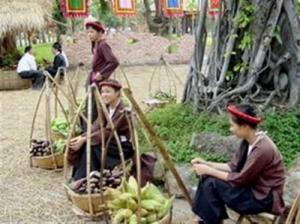Vietnamese Chả Giò: A Roll of Flavors and Tradition

From the long line of Vietnamese traditional food, Chả Giò is among those which strongly translate many of Vietnam’s colorful festivities, the Vietnamese inclination for abundance in taste, and a beautiful expression of close family ties. A popular Vietnamese dish, Chả Giò are tasty rolls of blended pork, shrimp and spices wrapped in rice papers then deep-fired until golden and crispy.
Served either as a main course or appetizer, these great-smelling and delicious little packages of goodness may be known as holiday treats, yet they can practically be served in any occasion or just any day when you desire a hearty snack.
Because of its flavorful character, its unique and exquisite cuisine makes Vietnam attractive across the globe apart from the rich culture, interesting history and wonderful sceneries it takes pride on. But for why Chả Giò is considered a staple food for the Vietnamese is a tell-tale sign of how the dish is close to many people’s heart, and most importantly, to their taste buds.
A Unique Identity
Chả Giò is often called by a lot of names. Crispy spring rolls, summer rolls, egg rolls and imperial rolls are just among the names associated to it. However, many Vietnamese cooks and Chả Giò lovers would argue that the closest and perhaps the most correct name to describe Chả Giò is Vietnamese fried egg rolls.
Sure everyone is familiar of the wheat-flour based, wonton-wrapped egg rolls in many Chinese restaurants around. Chả Giò is often mistakenly referred to as an egg roll or spring roll on many restaurant menus. As both dishes have fillings in a wrapper, and both cylindrical in shape, that wouldn’t come as much a surprise. Though the differences are not that enormous, Chả Giò, is in fact, a different dish with a lot of unique characteristics. You may think of it as a more delicate cousin of the Chinese egg rolls as they are wrapped with rice paper which is really thin, thus, gets very brittle especially when fried much longer.
Though its rice paper is its biggest distinction, another major difference between the two is that Chả Giò is also a bit smaller than the regular egg rolls. With just about the length of the finger, and equaling to three fingers in thickness, it is therefore lighter and a lot crispier than egg rolls. Typically, the filling of the Chinese egg rolls is made from a blend of chopped cabbage, bean sprouts, onions and could be tossed in with varying ingredients as well. Chả Giò, on the other hand, though also made from chopped vegetables, bean threads or bean sprouts, vermicelli noodles, and sometimes mushrooms and carrots, but it is never without meat (usually a combination of pork and shrimp). More so, Chả Giò is served with lettuce leaves, slices of fresh cucumbers and tempting garnishing like fresh cilantro and basil leaves.
With the characteristics of the rice paper being very delicate, Chả Giò easily turns crispy when fried and results to a beautiful blistered finish. Despite the superior crispness and remarkable browning property of the rice wrapper, when cooked, Chả Giò could only stay crispy for a few hours. Thus, is best consumed while freshly removed from the burner. All the confusion between the two may have stemmed from restaurants outside Vietnam who have adopted flour sheet or generic wrappers to make Chả Giò in place of the rice paper due to unavailability or for longer-lasting crisp quality. People who have spelled the difference between the two and have experienced the lightness of rice paper and the entirety of the dish itself would understand the need to isolate the two from each other and not to confuse the two separate dishes which has its own unique identity.
Tracing its Roots
Vietnam’s long expanse of borders made itself vulnerable to waves of countries coming to colonize the territory. Along with every invasion, different aspects of Vietnam’s totality are influenced. From religion to government, along with the people’s way of life, the diversity of the Vietnamese cuisine also started to take shape. Even up to present, Vietnamese cooking represents a mish-mash of influences, refined by native ingenuity, thus resulting to a truly unique cuisine.
With the centuries of being under the rule of China, the country had undeniably influenced Vietnamese cooking. Such is evident with the use of chopsticks, the art of stir-frying, noodle-rich recipes, and the use of bean curd. The almost one hundred years of colonization by the French also played a central role in the development of Vietnam’s cuisine. Techniques like sautéing is adopted along with the fascination for baguettes, café au lait, and gateaux. While Chinese influences are seen stronger in the north, people’s adaptation of more French-inclined cuisine seems more evident in the south.
With Chả Giò demonstrating close similarities to the Chinese rolls, it would be easy to think it is more of a dominantly Chinese influence. Considered one of Vietnam’s national dishes today, Chả Giò is said to be originally made for royalty which how it got one of its nicknames “imperial rolls”. The concept of combining vegetables, meat and rice wrappers into one sumptuous roll intends to delight the royal circle while at the same time serve a scrumptious meal that maintains a good balance of the yin and yang. However, there isn’t much written history about Chả Giò and if you try to trace its roots from both ends of Vietnam, they even call the dish by different names. Southern Vietnam calls it ‘Chả Giò’ while people from the north call it ‘Nem Rán’ or simply ‘Nem’.
Looking Beneath the Crispy Golden Rolls
The main structure of Chả Giò is a flavorful blend of seasoned ground meat and diced vegetables rolled up into a sheet of the slightly moistened thin rice paper. But every family in every kitchen could add in their own favorite ingredient, even take out some of the other ingredients, and develop their own Chả Giò recipe. Commonly, a single recipe of Chả Giò includes the following:
½ lb. or minced raw shrimp
½ lb. of lean ground pork
½ pound of bean sprouts
2 medium carrots, grated
2/z oz. cellophane noodles (bean threads)
2 medium white onions, chopped
3 teaspoons fresh ground black pepper
3 teaspoons salts
1 package round rice paper
2 eggs, beaten
Lettuce leaves
Vegetable oil for deep frying
2 to 3 minced shallots, if desired
¾ cup dried wood ear mushrooms, if desired
Though it takes a bit of time, the process is in fact simple. Mostly, it’s the mincing of the shrimps, grating the vegetables and chopping the spices into tiny sizes that consume time. Not to forget, wrapping the fillings and rolling them up is sort of a tedious procedure as well. But when everyone in the family chips in their effort, Chả Giò is actually fun to make.
To begin, combine the ground pork, minced shrimp, bean sprouts, shredded carrots and shallots, then set aside. Now, soak the cellophane noodles in a bowl of warm water for 15 to 30 minutes. If you have decided to include mushrooms in your recipe, soak them in a separate bowl, still with warm water, for about the same time. Drain the mushrooms and noodles thoroughly. Then, chop the mushrooms finely while the noodles are cut into three-inch segments, and add them to the meat mixture. Add the onions, black pepper and salt, then mix until well-blended. “Massaging” the meat mixture better distributes the flavor and allows it to sink in. When done, you can set them aside to rest for at least 15 minutes before rolling them, or if you choose, you can leave the mixture refrigerated overnight.
Using a pair of kitchen scissors, cut the rice wrappers into quarters (or halves, if larger rolls are desired), then separate each individual wrapper since they tend to adhere to one another in the package. When ready to roll, place one tablespoon of filling on round edge of the quarter-cut rice paper; roll over once, then tuck in the sides to enclose the filling and continue rolling all the way. If using halves, place about 1/3 cup of filling on one end, roll once, tuck in the sides and roll up just the same. You could prepare beaten eggs, brushed lightly on the edge of the paper, to hold the rolls together. Repeat the process until all of the wrappers and filling have been used.
In medium heat, place about 2 cups or more of vegetable oil in a wok or deep sauce pan. The oil should be at a depth of about 2 1/2 inches. When ready, Fry about eight rolls at a time until golden brown, about 15 minutes per batch. As you remove the rolls from the pan, drain them on paper towels. Add more oil when necessary. This recipe would yield about 50 small or 30 large Vietnamese egg rolls.
In a serving plate, line the lettuce leaves before topping them with Chả Giò rolls and garnish them with scallions. Every family could add in their own choice of garnishing, along with the sauce they wish to have their Chả Giò with. The rolls can either be eaten by itself, wrapped in lettuce leaves, dipped into ‘Nước Mắm (a popular Vietnamese fish sauce) or eaten with sweet and sour sauce with a slight twist of Sriracha hot sauce.
Helpful reminders from Vietnam’s renowned cooks include the stress to never overheat the oil, otherwise, the wrapper will turn golden before the filling is cooked through. It is also important that the folded side of Chả Giò to touch oil first to avoid unraveling. Others also suggest that frying using peanut oil keeps the rolls crispier than using other oils.
Chả Giò with a Twist
Like earlier stated, the ingredients of Chả Giò are not fixed. Recipes vary considerably from one from one household to another, from one restaurant to the next, each adding something new to include a different twist or for a newer adventure in taste. Though the most commonly used meat is ground pork, one can also use shrimp (which is commonly added in many Chả Giò recipes), chicken and sometimes even snails (in northern Vietnam). Crab is also popular but an expensive filling. “Vegan Chả Giò” uses tofu in place of the pork. In other countries, ground turkey is used to substitute the pork. Shredded cabbage is added if more vegetables are desired.
If diced carrots and jicama are used, the stuffing is a little bit crunchy, matching the crispy fried rice paper, but the juice from these vegetables can cause the rolls to soften after a short time. If the rolls are to be stored for a long time, mashed sweet potato or mung beans may be used instead to keep the rolls crispy. Eggs and various spices can be added to one's preference. Sometimes, the ingredients can include julienned taro root, which is known to give the rolls a fatty and crunchy texture.
Another variety, the “Chả Giò Rế”, uses the Bánh Hỏi (thin rice vermicelli woven into a sheet) to wrap the filling instead of rice paper. The stuffing inside the roll is the same as normal Chả Giò, and the roll is also deep fried. The sheets of Bánh Hỏi are narrow, and the rice vermicelli strands are brittle, Chả Giò Rế rolls are often small and difficult to make. They are only served in large parties and restaurants.
Chả Giò Inside and Outside Vietnam
In Vietnam, Chả Giò (or Nem Rán) is popular all throughout, readily available from the smallest food stalls in street corners to the finest restaurants. In America and many European countries, where there are large Vietnamese communities, it is usually served as an appetizer. Normally, Vietnamese food prioritizes appetite over nutrition and does not incline to sophisticated features like most of the Chinese food or aesthetic features like how Japanese food is prepared. But just like many good culinary ideas, Chả Giò was invented, refined then reinvented over and over again.
With so many variations, no wonder the spring roll is one of the most misunderstood foods, and Chả Giò is along the most confusedly-termed rolls. Think about it: Vietnamese Chả Giò, the Chinese egg rolls, lumpia from the Philippines, Malaysia’s popiah, how many more of these rolls’ cousins do you think are out there?
A Single Roll Holds A Lot of Meaning
Even with the many foreign influences, Vietnamese cuisine has retained a distinctive character through Vietnamese cooks' creative adaptation and innate skills of refinement. Though a large number of popular Vietnamese dishes translate a touch of foreign accommodation, the centuries and generations of constantly developing these dishes into the perfect blend of flavors to suit the taste, hearts and spirits of the wonderful people of Vietnam had shaped the now unique, exquisite and truly delicious Vietnamese cuisine which includes the renowned Chả Giò. A layer of flavor wrapped in every roll of crispy-browned rice wrapper, hugged by crispy, fresh lettuce would sure make every mouth water. Every bite of the crispy blister-textured Chả Giò resonates not only the sound of pure flavor, but also the Vietnamese creative spirit and close family ties which came about the birth of this tasty treat along with the rest of Vietnam’s wonderful cuisine.









